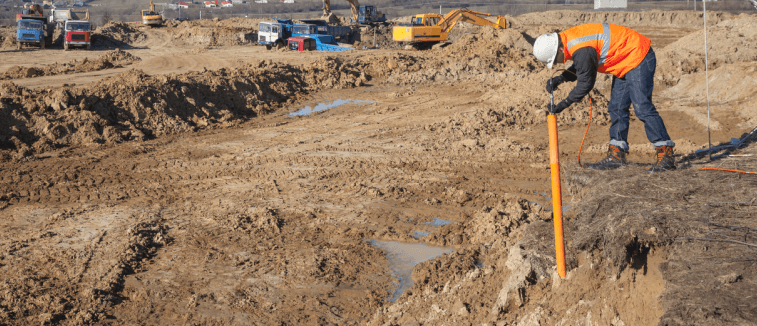More About Geotheta
More About Geotheta
Blog Article
Getting My Geotheta To Work
Table of ContentsThe Only Guide to GeothetaGeotheta Can Be Fun For EveryoneAll about GeothetaThe 7-Minute Rule for GeothetaNot known Details About Geotheta

They carry out website investigations, accumulate examples, perform laboratory tests, and evaluate information to evaluate the viability of the ground for building and construction jobs - Consulting Engineer. Based upon their searchings for, geotechnical engineers offer referrals for structure layout, slope security, maintaining structures, and mitigation of geotechnical threats. They team up with various other professionals, such as architects, structural engineers, and building and construction groups, to make certain that geotechnical considerations are integrated into the total project layout and application
By examining the habits and residential properties of dirt and rock, they can recognize potential geotechnical risks such as landslides, dirt negotiation, or slope instability. Their know-how aids avoid failings or crashes that might jeopardize lives and residential property. Here are some thorough obligations and obligations of a geotechnical engineer: Site Investigation: Geotechnical designers conduct website examinations to collect information on subsurface conditions.
They translate the data to comprehend the homes and habits of the dirt and rock, including their stamina, permeability, compaction attributes, and groundwater problems. Geotechnical Analysis and Style: Geotechnical designers examine the data accumulated throughout site investigations to examine the security and viability of the website for building and construction jobs. They do geotechnical calculations and modeling to review aspects such as bearing capacity, negotiation, incline stability, lateral earth stress, and groundwater flow.
About Geotheta
Structure Design: Geotechnical designers play an important duty in creating structures that can safely support the designated framework. They examine the dirt problems and tons demands to determine the proper structure type, such as shallow structures (e.g., footings), deep structures (e.g (https://geotheta-46958753.hubspotpagebuilder.com/blog/unlocking-the-future-with-top-notch-geotechnical-engineers-at-geotheta)., stacks), or specialized techniques like dirt renovation. They take into consideration elements such as negotiation restrictions, birthing capability, and soil-structure communication to establish optimum structure layouts
They assess building and construction plans, display site tasks, and carry out field inspections to validate that the layout referrals are adhered to. If unforeseen geotechnical issues arise, they examine the scenario and give referrals for remediation or modifications to the design. Danger Evaluation and Mitigation: Geotechnical engineers evaluate geotechnical hazards and risks connected with the job website, such as landslides, liquefaction, or dirt disintegration.

Collaboration and Communication: Geotechnical designers function closely with other specialists associated with a task, such as engineers, structural designers, and construction teams. Efficient communication and collaboration are important to integrate geotechnical factors to consider right into the total project style and building process. Geotechnical engineers offer technological competence, response inquiries, and guarantee that geotechnical requirements are fulfilled.
The Ultimate Guide To Geotheta
Below are some kinds of geotechnical designers: Structure Engineer: Foundation designers focus on creating and assessing structures for frameworks. They analyze the dirt problems, load demands, and site attributes to establish one of the most appropriate structure kind and layout, such as shallow foundations, deep foundations, or specialized techniques like pile structures.
They assess the elements influencing slope security, such as soil properties, groundwater conditions, and incline geometry, and establish methods to stop slope failings and reduce dangers. Earthquake Engineer: Quake designers concentrate on assessing and designing structures to hold up against seismic pressures. They analyze the seismic hazard of a site, examine soil liquefaction capacity, and create seismic style requirements to guarantee the security and durability of frameworks throughout quakes.
They perform field testing, gather examples, and assess the accumulated information to characterize the dirt properties, geologic developments, and groundwater problems at a website. Geotechnical Instrumentation Engineer: Geotechnical instrumentation designers concentrate on monitoring and determining the habits of soil, rock, and structures. They mount and preserve instrumentation systems that keep an eye on aspects such as dirt settlement, groundwater degrees, incline activities, and structural displacements to examine efficiency and supply very early cautions of possible problems.
Geotheta - Truths
They carry out examinations such as triaxial examinations, loan consolidation tests, straight shear tests, and leaks in the structure tests to gather data for geotechnical analysis and style. Geosynthetics Engineer: Geosynthetics engineers concentrate on the style and application of geosynthetic products, such as geotextiles, geogrids, and geomembranes. They use these products to improve soil security, reinforce inclines, supply drain options, and control disintegration.
They have a tendency to be investigative individuals, which suggests they're intellectual, view introspective, and investigative. They wonder, methodical, rational, analytical, and rational. Some of them are likewise social, suggesting they're kind, generous, participating, patient, caring, handy, empathetic, tactful, and friendly. Does this audio like you? Take our totally free career examination to learn if geotechnical engineer is one of your top career matches.
In the office atmosphere, geotechnical designers use specialized software application tools to execute estimations, create styles, and examine information. They prepare reports, testimonial task specifications, communicate with clients and employee, and coordinate task activities. The workplace setup gives a helpful atmosphere for research study, evaluation, and collaboration with various other experts involved in the project.
3 Easy Facts About Geotheta Shown
They frequently go to task websites to carry out website investigations, evaluate geotechnical problems, and collect information for analysis. These check outs involve taking a trip to various locations, in some cases in remote or difficult terrains. Geotechnical designers may do dirt tasting, conduct tests, and display building tasks to make certain that the geotechnical facets of the job are being applied correctly.
Geotechnical designers additionally work in specialized geotechnical research laboratories. Geotechnical lab designers work extensively in these environments, handling testing equipment, operating instruments, and taping information.
Report this page